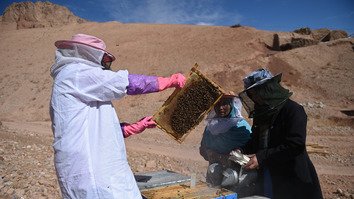KABUL -- Naya, a three-year-old Belgian Malinois, focuses intently as she leaps over hurdles and zooms through tunnels on an obstacle course at a training centre on a hill overlooking Kabul.
She seems to be having fun but is in fact being trained for a life-or-death mission: finding explosives in Afghanistan, where hidden mines, bombs and weapons routinely kill.
Naya is one of about 200 dogs at the Mine Detection Centre (MDC), a non-governmental group raising the animals from rambunctious pups into a disciplined force and teaching handlers how to work with the canines.
A common sight around Kabul, explosive-sniffing dogs are deployed at checkpoints and government facilities, where they are an important tool in combatting the flow of homemade bombs being smuggled into the city.
![Afghan dog handlers walk along with explosive detection dogs on leash during a practice session at the Mine Detection Centre in Kabul on April 7. [Wakil Kohsar/AFP]](/cnmi_st/images/2019/08/05/18989-000_1ik2nn-585_329.jpg)
Afghan dog handlers walk along with explosive detection dogs on leash during a practice session at the Mine Detection Centre in Kabul on April 7. [Wakil Kohsar/AFP]
"The dogs are very useful -- they are very fast; they do their jobs with great speed," Taj Mohammad, a long-time trainer at the centre, told AFP on a recent visit.
Handlers demonstrated how they train dogs to home in on particular scents -- explosives mainly but also narcotics -- by using a special carousel of identical metal canisters that conceal different smells.
Each time a dog correctly identifies a target smell, the handler gives it a rubber chewy ball to chomp on as a reward.
"The relationship with the handler must be perfect," Mohammad said. "If it does not work, there will be casualties."
It takes about two years to train an explosives dog, and the process is intense for both the handler and the canine. The animals at the MDC are all German Shepherds or Belgian Malinois.
"It's as if you are building a house or bringing up a child," Mohammad said.
Handlers get about $500 (39,250 AFN) a month for their dangerous work as well as life insurance and retirement benefits.
Explosives are "a hidden enemy, so all the time I have a little fear in my heart", said dog handler Zabihullah Amin.
At the MDC, handlers insist dogs are a better tool for finding mines than are mechanical detectors, as they can sniff the explosives in non-metallic devices.
At least 1,432 people were killed or wounded in Afghanistan by mines and so-called explosive remnants of war in 2018, according to Abdul Qudos Ziaee, head of operations at Afghanistan's Directorate of Mine Action Coordination.
Mohammad Wirwais, who works at the MDC, was blinded by a mine while clearing terrain in 2008.
"I am fortunate and lucky," he said. "I have friends ... who lost their lives to mine explosions."
"I am good, thank God; I can solve my problems on my own, and I can work here too."

![An explosive detection dog searches in a field as Afghan dog handlers keep watch during a practice session at the Mine Detection Centre in Kabul on April 7. [Wakil Kohsar/AFP]](/cnmi_st/images/2019/08/05/18990-000_1ik28e-585_329.jpg)
![An Afghan dog handler looks on as an explosive detection dog searches a car during a practice session at the Mine Detection Centre in Kabul on April 7. [Wakil Kohsar/AFP]](/cnmi_st/images/2019/08/05/18991-000_1ik28a-585_329.jpg)
![An Afghan dog handler guides a detection dog to search for explosives during a practice session at the Mine Detection Centre in Kabul on April 7. [Wakil Kohsar/AFP]](/cnmi_st/images/2019/08/05/18992-000_1ik27w-585_329.jpg)
![An explosive detection dog is kept on leash during a practice session at the Mine Detection Centre in Kabul on April 7. [Wakil Kohsar/AFP]](/cnmi_st/images/2019/08/05/18993-000_1ik28b-585_329.jpg)
![An explosive detection dog goes over an obstacle during a practice session at the Mine Detection Centre in Kabul on April 7. [Wakil Kohsar/AFP]](/cnmi_st/images/2019/08/05/18994-000_1ik288-585_329.jpg)
![An Afghan dog handler trains young explosive detection dogs during a practice session at the Mine Detection Centre in Kabul on April 7. [Wakil Kohsar/AFP]](/cnmi_st/images/2019/08/05/18998-000_1ik28c-585_329.jpg)
![An explosive detection dog goes through an obstacle course during a practice session at the Mine Detection Centre in Kabul on April 7. [Wakil Kohsar/AFP]](/cnmi_st/images/2019/08/05/18999-000_1ik287-585_329.jpg)
![Afghan dog handlers stand as explosive detection dogs sit next to them during a practice session at the Mine Detection Centre in Kabul on April 7. [Wakil Kohsar/AFP]](/cnmi_st/images/2019/08/05/19000-000_1ik28g-585_329.jpg)






